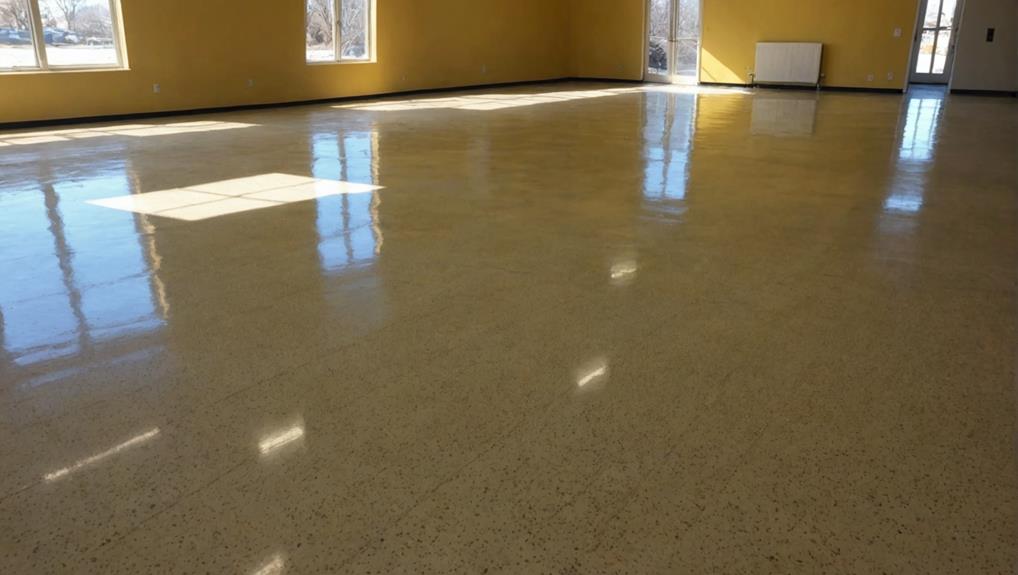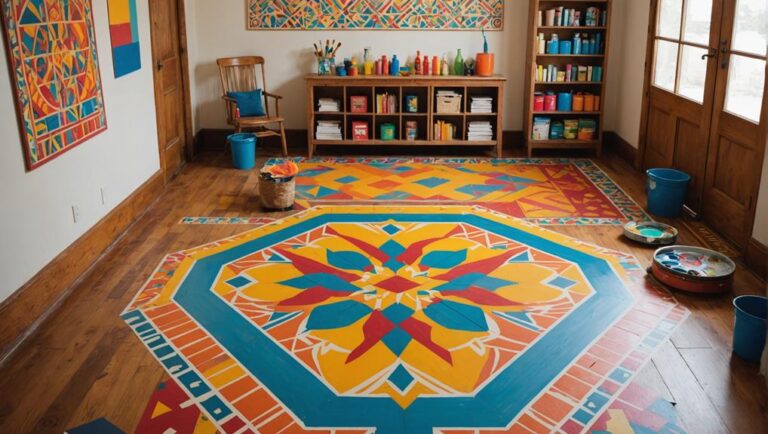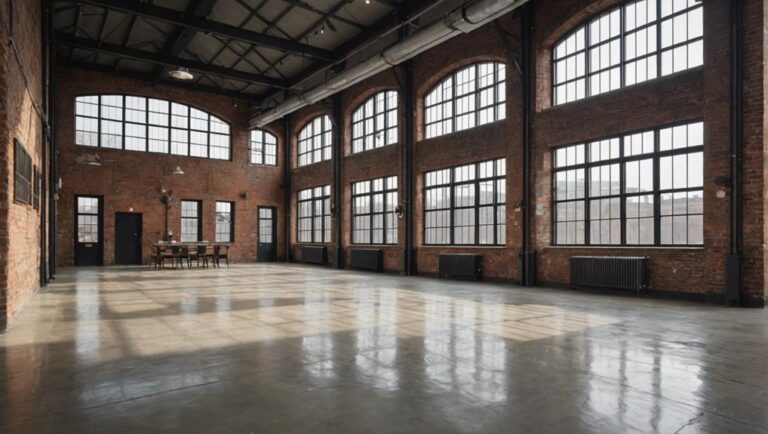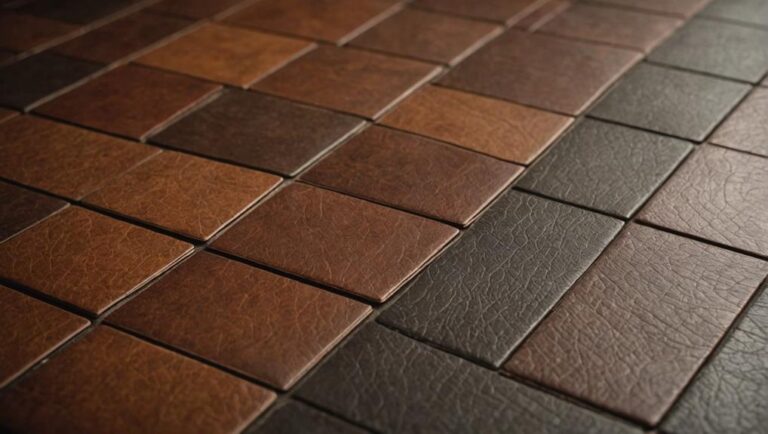To avoid yellowing in floor coatings, focus on using high-quality, UV-resistant products that contain stabilizers. Proper surface preparation is essential; make certain the substrate is clean to enhance adhesion. Pay attention to application techniques—maintain consistent speed and pressure, and guarantee the correct film thickness. Environmental factors, like humidity and temperature, should also be controlled to prevent issues during curing. Regular maintenance, such as weekly deep cleaning with pH-neutral cleaners, will keep contaminants at bay. By implementing these strategies, you'll maintain a lasting, aesthetically pleasing finish, and there's much more to discover about enhancing your flooring's durability.
Common Causes of Yellowing
Yellowing in floor coatings can stem from several common causes, each with its own implications for longevity and appearance. One of the primary culprits is the occurrence of chemical reactions between the coating materials and environmental factors. For instance, exposure to ultraviolet (UV) light can trigger these reactions, causing certain resins to break down and yellow over time. It's vital to choose products that offer UV resistance to mitigate this risk.
Another important factor contributing to yellowing is the presence of surface contaminants. Dust, oils, and other residues can interact with the coating, leading to discoloration. When these contaminants accumulate, they can create a barrier that traps moisture and promotes degradation, further exacerbating the yellowing process. Regular cleaning and maintenance can help prevent these surface contaminants from settling, prolonging the life of your floor coating.
Additionally, improper application techniques can lead to chemical imbalances in the coating. If the mixing ratios aren't adhered to or if incompatible products are used, you may notice an accelerated yellowing effect. Always follow manufacturer guidelines to guarantee you're using the right products and methods.
To maintain the aesthetic and functional integrity of your floor coatings, it's important to be aware of these common causes of yellowing. By implementing preventive measures, you can greatly enhance the durability and safety of your flooring while preserving its original appearance.
Importance of Quality Coatings
When selecting floor coatings, you can't underestimate the importance of quality materials. High-performance coatings offer enhanced durability and UV resistance, which are vital for preventing yellowing over time. Additionally, the application method can greatly influence the final result, so it's important to take into account how these factors interact to guarantee peak performance.
Material Durability Considerations
In selecting floor coatings, considering material durability is essential for ensuring long-lasting performance. A durable coating not only enhances the material lifespan but also improves coating performance, making it vital for maintaining safety and aesthetic appeal in high-traffic areas. Low-quality coatings can lead to premature wear, increased maintenance costs, and potential safety hazards due to slips or uneven surfaces.
To help you evaluate different coating options, here's a table outlining key durability factors:
| Coating Type | Material Lifespan | Coating Performance |
|---|---|---|
| Epoxy | 5-10 years | Excellent adhesion |
| Polyurethane | 7-15 years | High abrasion resistance |
| Acrylic | 3-5 years | Moderate flexibility |
| Urethane | 5-10 years | Good chemical resistance |
| Cementitious | 10+ years | Very strong durability |
UV Resistance Features
Quality floor coatings must incorporate UV resistance features to prevent degradation from sun exposure, which can lead to unsightly yellowing. UV exposure is a significant factor that affects the integrity of coatings, especially in environments with direct sunlight. When coatings lack adequate UV protection, they can break down chemically, resulting in reduced aesthetic appeal and compromised performance.
Choosing a coating with robust UV resistance extends the coating lifespan dramatically. This guarantees that your floors not only maintain their original color but also resist cracking and peeling caused by prolonged sun exposure. High-quality coatings often contain UV stabilizers that absorb harmful rays, thereby mitigating the effects of UV degradation.
Investing in UV-resistant coatings is also a safety measure. Floors that yellow or deteriorate can become slippery, increasing the risk of accidents. By prioritizing UV resistance in your flooring choice, you're enhancing the overall safety and functionality of the space.
When considering floor coatings, always verify the UV resistance features. This diligence not only protects your investment but also preserves the aesthetic and safety of your environment for years to come.
Application Method Impact
The effectiveness of a floor coating isn't solely determined by its formulation; the application method plays a vital role in achieving ideal performance and longevity. Whether you choose spray techniques or roller application, understanding their impact can greatly influence the coating's durability and resistance to yellowing.
- Surface Preparation: Confirm the substrate is clean and free from contaminants. Proper preparation maximizes adhesion, reducing the risk of peeling and yellowing over time.
- Environmental Conditions: Apply coatings in suitable temperatures and humidity levels. Excess moisture or extreme temperatures can lead to improper curing, compromising the coating's integrity.
- Application Thickness: Achieving the right film thickness is essential. Too thin a layer may lead to insufficient protection, while too thick can cause bubbling or premature yellowing.
- Technique Consistency: Whether using spray techniques or roller application, maintain a consistent speed and pressure. This guarantees an even distribution, which is key to preventing localized discoloration.
Selecting UV-Resistant Products
When selecting floor coatings, ensuring UV resistance is vital to prevent yellowing over time. You'll want to look for products that feature advanced UV stabilizers and high-performance resins for ideal durability. Additionally, comparing various coating options can help you identify those that best meet your specific environmental and aesthetic needs.
Importance of UV Resistance
Selecting UV-resistant products is essential for maintaining the aesthetic and functional integrity of floor coatings over time. When you consider UV exposure, it's critical to choose coatings that incorporate protective additives. These additives help mitigate the sunlight effects that can lead to surface degradation and diminished color stability.
Here are four key factors to keep in mind when selecting UV-resistant products:
- Coating Lifespan: Products designed with UV resistance often have a longer coating lifespan, reducing the need for frequent reapplications.
- Heat Resistance: Effective UV-resistant coatings can withstand higher temperatures, minimizing the risk of heat-induced chemical interactions that can compromise the coating's integrity.
- Long-Term Performance: Investing in UV-resistant options enhances long-term performance, ensuring that the surface remains functional and visually appealing over time.
- Environmental Impact: Selecting products with UV resistance can also reduce the environmental impact by decreasing the frequency of maintenance and disposal associated with less durable coatings.
Recommended Product Features
Choosing the right features in UV-resistant products can make a significant difference in the longevity and performance of your floor coatings. When selecting these products, prioritize formulations that include advanced UV stabilizers. These additives enhance color stability, guaranteeing your floors maintain their original hue over time, even under prolonged sun exposure.
Look for eco-friendly options that utilize non-toxic materials. Many manufacturers now offer products that are both effective in preventing yellowing and safe for indoor air quality. These formulations can provide peace of mind, knowing you're making a responsible choice for your environment.
Another key feature to contemplate is the product's thickness and application method. Thicker coatings generally provide better protection against UV degradation, while specific application techniques can enhance the overall durability of the finish.
Lastly, verify that the product you choose has been tested rigorously for UV resistance. Certifications or lab results can provide essential insights into the product's performance under real-world conditions. By focusing on these recommended features, you'll be better equipped to select a UV-resistant floor coating that not only looks great but also stands the test of time.
Comparing Coating Options
Evaluating various coating options is fundamental for guaranteeing your floors remain vibrant and resistant to yellowing over time. When selecting UV-resistant products, consider the following:
- Polyurethane Coatings: Known for their durability and excellent color stability, these coatings offer strong resistance to yellowing, making them ideal for high-traffic areas.
- Epoxy Coatings: With superior adhesion and coating thickness, epoxy can provide a robust barrier against yellowing, especially when properly applied with thorough surface preparation.
- Acrylic Finishes: While generally less durable than polyurethane, certain acrylic finishes can be formulated to enhance UV resistance, offering a good balance of aesthetics and performance.
- Finish Types: Choosing the right finish type is essential. Matte finishes tend to hide imperfections but may require more maintenance, while glossy finishes can enhance color stability but might show wear more noticeably.
Ultimately, understanding the long-term performance of these coatings is critical. By carefully selecting a product that aligns with your specific needs, you can guarantee your floors stay beautiful and resistant to yellowing for years to come.
Proper Application Techniques
To achieve ideal results in floor coating application, meticulous attention to detail is vital. Proper application techniques can greatly affect the durability and aesthetic of your floor coatings, particularly in preventing yellowing over time. When selecting your method, consider the differences between spray techniques and roller applications, as each has its own advantages and challenges.
If you opt for spray techniques, verify that you're using a high-quality sprayer designed for the specific coating material. This method allows for an even distribution of the coating, reducing the risk of uneven surfaces that can lead to discoloration. Always maintain a consistent distance and angle while spraying to avoid drips and runs. Additionally, it's essential to apply in well-ventilated areas to facilitate proper curing and minimize exposure to potentially harmful vapors.
On the other hand, roller applications can be an excellent choice for smaller areas or detailed work. Use a roller with the appropriate nap thickness for your coating type; a thicker nap will hold more material and provide better coverage. Apply the coating in long, even strokes, and avoid overloading the roller to maintain an even layer. Remember to work in sections to verify that you don't miss any spots and to maintain a wet edge, which helps prevent lap marks.
Regardless of the method you choose, always follow the manufacturer's guidelines for recommended thickness and environmental conditions. Proper application is key to achieving a long-lasting, beautiful finish.
Regular Maintenance Practices
Once you've applied your floor coating with the right techniques, maintaining its appearance and integrity becomes paramount. Regular maintenance practices not only enhance the aesthetic appeal of your floors but also extend the lifespan of the coating, effectively preventing yellowing. To achieve this, you should establish and adhere to a structured cleaning schedule.
Here are four essential maintenance practices to keep your floor coatings in ideal condition:
- Daily Cleaning: Use a soft-bristle broom or a microfiber mop to remove dirt and debris. This prevents scratches and minimizes wear on the coating.
- Weekly Deep Cleaning: Employ a pH-neutral cleaner and a damp mop to thoroughly clean the floor. Avoid harsh chemicals, as they can contribute to yellowing over time.
- Monthly Inspections: Regularly inspect the coating for signs of wear, such as scratches or discoloration. This proactive approach allows you to address minor issues before they escalate.
- Use Appropriate Maintenance Tools: Invest in high-quality maintenance tools, such as non-abrasive pads and soft mops, to guarantee effective cleaning without damaging the floor coating.
Environmental Factors to Consider
When considering the longevity and appearance of your floor coatings, environmental factors play an essential role. One of the most important aspects is humidity control. High humidity can compromise the integrity of the coating, leading to issues like bubbling or peeling, while low humidity can cause the materials to dry too quickly, impacting adhesion. As a result, maintaining ideal humidity levels is necessary.
Temperature fluctuations also considerably affect floor coatings. Extreme changes can cause expansion and contraction of the flooring materials, resulting in cracks or gaps. It's imperative to apply coatings within a temperature range specified by the manufacturer to guarantee proper curing.
Air quality is another consideration. Poor indoor air quality can lead to chemical interactions that may degrade floor coatings over time. Guarantee adequate ventilation during application to minimize harmful compound buildup.
Sunlight exposure is often overlooked but can accelerate yellowing in coatings, particularly those with a high resin content. If your floors are exposed to direct sunlight, consider using UV-resistant products to prolong their aesthetic appeal.
Lastly, proper surface preparation is important. Any contaminants, such as dust or grease, can hinder adhesion and lead to premature failure. Always confirm your flooring materials are clean and dry before application.
When to Seek Professional Help
Maintaining ideal environmental conditions is important, but sometimes the complexities of floor coating application can exceed your expertise. If you're encountering issues that could jeopardize the integrity of your flooring, it's essential to recognize when to seek professional help. Engaging a contractor with experience guarantees the right techniques and materials are used, safeguarding against potential hazards like yellowing.
Here are four signs that indicate it might be time to call in the professionals:
- Persistent Yellowing: If the yellowing persists despite following best practices, a contractor can evaluate the materials and application methods to identify underlying causes.
- Inconsistent Results: If your DIY efforts yield inconsistent finishes or textures, a professional can assure uniformity and long-lasting results.
- Tight Project Timeline: If you're under a strict timeline for completion, hiring an experienced contractor can expedite the process without compromising quality.
- Health and Safety Concerns: If you're unsure about handling potentially hazardous materials or equipment, it's wise to have a professional manage these to guarantee safety and compliance with regulations.
Professional contractors offer valuable insights and solutions that not only enhance the aesthetic of your floors but also prolong their lifespan. By investing in contractor experience, you can mitigate risks and guarantee your project timeline remains intact. Don't hesitate to reach out for expert assistance when the situation calls for it.
Frequently Asked Questions
Can I Use Regular Paint Instead of Specialized Floor Coatings?
Using regular paint instead of specialized floor coatings might seem like a penny saved today, but it's a false economy. You're looking at a significant cost comparison over time due to durability factors. Regular paint lacks the abrasion resistance and chemical resilience needed for high-traffic areas. It'll wear down quickly, requiring more frequent reapplications, which can compromise safety. In the long run, it's wiser to invest in quality floor coatings designed for the task.
How Long Do Floor Coatings Typically Last Before Yellowing Occurs?
Floor coatings typically last anywhere from 5 to 15 years, depending on the material and environmental factors. To enhance floor coating durability and combat yellowing, choose high-quality, UV-resistant products. Proper installation and maintenance also play critical roles in longevity. Regular cleaning and avoiding harsh chemicals can prevent degradation. Ultimately, by prioritizing yellowing prevention techniques, you can greatly extend the life of your floor coatings, ensuring both safety and aesthetic appeal over time.
Are There Specific Cleaning Products That Prevent Yellowing?
When it comes to preventing yellowing, you should consider using specific cleaning agents designed for your flooring type. Look for products that contain protective additives, which can help maintain the integrity of the coating. These cleaning agents not only clean effectively but also provide a barrier against UV light and pollutants that contribute to discoloration. Always guarantee the products you choose are safe for your floors and follow the manufacturer's recommendations for best results.
Will Indoor Lighting Affect the Yellowing of Floor Coatings?
Yes, indoor lighting can greatly affect yellowing in floor coatings. UV exposure from certain lighting types, such as fluorescent or LED lights, can lead to chemical reactions that cause discoloration. Using lighting with lower UV emissions can help minimize this effect. It's crucial to choose appropriate fixtures and bulbs to maintain floor coating integrity. Regularly monitoring lighting conditions can guarantee your floors remain vibrant and safe from premature degradation.
How Often Should I Reapply Floor Coatings to Avoid Yellowing?
Isn't it amusing how you think you can just coat your floors once and forget about them? In reality, the reapplication frequency depends on coating types and usage. Generally, you should consider reapplying every 1-3 years, especially in high-traffic areas. Regular maintenance not only enhances safety but also prolongs the life of your floors, preventing potential hazards from wear and tear. Stay proactive, and your floors will thank you!




